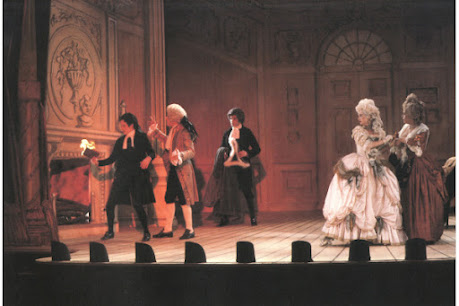 |
| Anne Baxter, Michael Wager, Kurt Johnson, and Sean Young |
The Merchant Ivory menage and film company, including screenwriter Ruth Prawer Jhabvala and composer Richard Robbins, had settled in New York during the 1970s. Jane Austen in Manhattan was the eighth screenplay that Jhabvala had concocted for producer Ismail Merchant and director James Ivory and was something of a fluke. The duo had purchased the rights to a play based on Samuel Richardson's novel Sir Charles Grandison by a youthful Jane Austen. However, the manuscript turned out to be a fragment, not a complete work. What of it there is shows little of Austen's talent. It is a knockoff of Richardson's usual damsel in distress schtick. Ms. Jhabvala was left to make something out of this debacle. She wrote the screenplay as if the complete play existed and pictures two rival theatrical impresarios angling to get funding for a production. One is a theatrical veteran named Lilliana and played by Anne Baxter who represents a traditional and crowd pleasing approach. The other, named Pierre and played by Robert Powell, is an avant-garde guru who prefers an edgier aesthetic.
Pierre closets his troupe from the outside world. They all live and rehearse together in a polyamorous commune. The members of the troupe all have outside jobs, but they give the money they earn to Pierre, as they would to a pimp. Pierre and Lilliana have a shared history which we glimpse in ineffective flashbacks. Baxter and Powell have zilch in the way of chemistry. Pierre is supposed to have a whiff of satanic decadence about him, one character refers to a cloven hoof, but Powell just seems distant and batty. The ideal actor for the role would have been Peter O' Toole who brought a lot of Lucifer to the role of a film director in 1980's The Stunt Man. Baxter fares a little better in this her last film, but I can't forgive the hideous outfits she has to wear and the indignity of her doing a scene in curlers. New York is accurately depicted as a pretty gritty place to live at the time, but the costumes are all at least five years out of date. The no wave New York of the time doesn't exist in this movie except for a Ramones sticker on a door.
The other primary relationship in the movie, besides Pierre and Lilliana, is between Victor (Kurt Johnson), a young song and dance man, and his wife, untested actress Ariadne (Sean Young). Ariadne is enmeshed in Pierre's cult, drawing the romantic attentions of both Pierre and a folk singer named Katya (Katrina Hodiak). Victor is having onstage success in a frothy musical, but is understandably miffed at Ariadne's estrangement from him. There is a little hint that the film is trying to link this strand of the plot with the rake's abduction of the heroine in the play, but it is half-assed and unconvincing. Mr. Johnson is great when shown rehearsing musical numbers, but is instant Sominex in the dramatic scenes. It is fun to Sean Young, in her first screen role, before she became a botoxed replicant. Her inexperience seems charming rather than awkward and true to the character. Ms. Hodiak, daughter of Ms. Baxter and John Hodiak, is cursed with an under-written character. However, she is solely responsible for the god awful folk songs she performs which tend to bring whatever momentum the movie is accumulating to a screeching halt.
The folk singer character also seems to emanate from a 1960s time warp that did not exist in 1980 New York except in Ruth Jhabvala's mind. I feel that the dichotomy she was drawing between mainstream and experimental theater was out of date by then. Come to think of it, when we do see Pierre's production it is very reminiscent of Peter Brook's late 1960s extravaganzas: particularly Marat/Sade and A Midsummer's Night Dream. Ms. Jhabvala's screenplay tries to gives us the feel of an ensemble in production, as in Jacques Rivette's masterpiece Out 1, but bites off more than she can chew. Another romantic duo of Nancy New (pleasant) and Tim Choate (outstanding) is one too many. What attempts to be a rich and multi-dimensional film ends up being over-stuffed.
There are some interesting aspects to the film, though. Richard Robbins not only had to compose a traditional score, but a faux opera number or two for Lilliana's show. The result, which sounds like a mash-up of The Abduction from the Seraglio and The Beggar's Opera, is effective and piquant. Despite Jane Austen in Manhattan's threadbare and shambolic nature, Merchant Ivory productions were always on the verge of collapsing, James Ivory's direction shows signs of growth. When Pierre and Ariadne visit a Sufi service in their building, Ivory pulls his camera back to show the whole room reverberating with music and rhythmic dance. He is striving to capture the religious fervor and union of the group. When he uses this technique later in his career, usually in English manor house, it is often to show the gulf between characters in cavernous rooms.
Another moment I enjoyed was a monologue by Michael Wager playing George, a guileless fat cat whom Lilliana is hitting up for backing. In his luxe penthouse, George recounts a Sisyphean tales from his childhood about an older bully repeatedly smashing George's sand castles. A winning moment from Mr. Wager that Ivory helps along with his placement of the Empire State Building in the background. The message, like that of Shelley's Ozymandias, is billboarded for us: all our vain efforts will be washed away by the sands of time. A few more moments like these and I might have considered Jane Austen in Manhattan to be a good film.






No comments:
Post a Comment